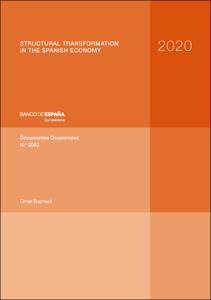Structural transformation in the Spanish economy
Autor
Fecha de publicación
29-ene-2020
Descripción física
36 p.
Resumen
Este artículo estudia la variación de la composición sectorial de la economía española desde 1980 hasta 2015 desarrollando un modelo de equilibrio general de transformación estructural con dos sectores: servicios y manufacturas. Utilizando las sendas de productividad sectoriales observadas en los datos como shocks exógenos, el modelo reproduce la variación de la cuota de los servicios en el producto bruto total de la economía española entre 1980 y 2015. Incluso en ausencia de cambios en las tendencias de las productividades sectoriales, en el modelo la tasa de crecimiento anual del PIB entre 2015 y 2050 se reduce en 0,6 puntos porcentuales con respecto a la tasa de crecimiento promedio hasta 2015. Por lo tanto, el crecimiento anual del PIB disminuiría de 2,3% a 1,7%. Si las productividades sectoriales fueran iguales a los niveles de la zona del euro, la tasa media de crecimiento del PIB español entre 2015 y 2050 sería del 2,1%.
This paper studies how the variation in sectoral productivities shapes the sectoral composition of the Spanish economy from 1980 to 2015. I first document an asymmetric behavior of sectoral productivities: the productivity of services declines over time, whereas the productivity of manufacturing increases until the 1990s, before slowing down. I feed the path of sectoral productivities observed in the data into a model of structural transformation with two sectors (services and manufacturing) which are connected by an Input-Output matrix. The model reproduces the variation of the gross output services share of the Spanish economy between 1980 and 2015. The model implies that – even absent changes in the trends of sectoral productivities – the annual growth rate of GDP between 2015 and 2050 shrinks by 0.6 percentage points with respect to the average growth rate between 1980 and 2015. Hence, annual GDP growth would decline from 2.3% to 1.7%. If sectoral productivities were to equal the levels observed in the Euro Area between 1980 and 2015, the average growth rate of Spanish GDP between 2015 and 2050 would be 2.1%.
This paper studies how the variation in sectoral productivities shapes the sectoral composition of the Spanish economy from 1980 to 2015. I first document an asymmetric behavior of sectoral productivities: the productivity of services declines over time, whereas the productivity of manufacturing increases until the 1990s, before slowing down. I feed the path of sectoral productivities observed in the data into a model of structural transformation with two sectors (services and manufacturing) which are connected by an Input-Output matrix. The model reproduces the variation of the gross output services share of the Spanish economy between 1980 and 2015. The model implies that – even absent changes in the trends of sectoral productivities – the annual growth rate of GDP between 2015 and 2050 shrinks by 0.6 percentage points with respect to the average growth rate between 1980 and 2015. Hence, annual GDP growth would decline from 2.3% to 1.7%. If sectoral productivities were to equal the levels observed in the Euro Area between 1980 and 2015, the average growth rate of Spanish GDP between 2015 and 2050 would be 2.1%.
Publicado en
Documentos Ocasionales / Banco de España, 2003
Materias
Análisis sectorial; Matriz de Input-Output; Economía española; Sectoral analysis; Input-Output matrix; Spanish economy; Evolución y desarrollo económicos; Producción y mercado; Sistemas económicos; Mercado de trabajo; España
Aparece en las colecciones:












